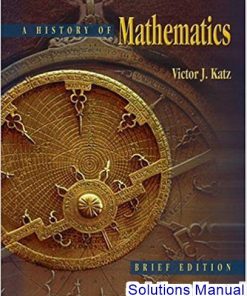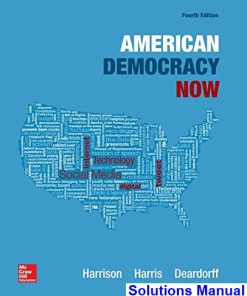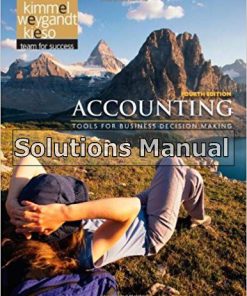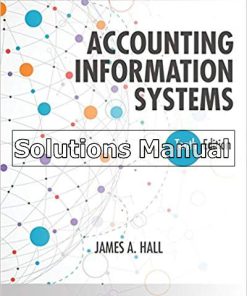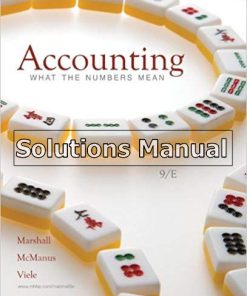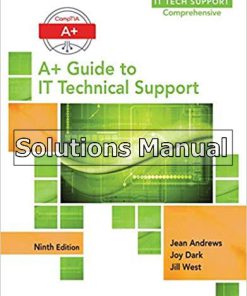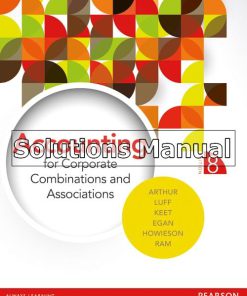Living Democracy Brief National Edition 1st Edition Shea Solutions Manual
$26.50$50.00 (-47%)
Living Democracy Brief National Edition 1st Edition Shea Solutions Manual.
You may also like
This is completed downloadable of Living Democracy Brief National Edition 1st Edition Shea Solutions Manual

Product Details:
- ISBN-10 : 0136132146
- ISBN-13 : 978-0136132141
- Author:
Living Democracy gets students to participate in learning, in the classroom, and in change. The book’s young and energetic author team cares deeply about student learning and student engagement. Lead author Dan Shea founded the Center for Political Participation and his experiences working with students in the classroom and in the center inspired him to team up with co-authors Joanne Connor Green (Texas Christian University) and Christopher E. Smith (Michigan State) to write an American Government text that truly inspires students and helps them experience the impact of government in their daily lives. Everything about the book–the writing, design, examples, photos, activities, and every page of the text–is designed to get students to participate in their class and in American politics.
Table of Content:
Chapter 1 American Government: Democracy in Action American Democracy and the Individual Citizen The Unique Democracy of the United States Themes of This Book Citizen Participation in Democratic Government Pathways of Action Diversity in American Society Citizen Participation and Pathways: The Example of Abortion Change and Stability in American Government Sources of Stability Conclusion Chapter 2 Early Governance and the Constitutional Framework The Cry for Liberty, Equality, . . . and Slavery? The Nature of Government and Politics Types of Governments Economic Systems Early Governance in America The American Revolution The Declaration of Independence The Colonial Experience and the Pathways of Change The Articles of Confederation Limitations of the Articles of Confederation Shays's Rebellion: An Alternative Look The Constitutional Convention The Great Compromise The Three-Fifths Compromise The Sectional Compromise The U.S. Constitution The Struggle over Ratification The Federalist Papers The Anti-Federalists' Response Other Challenges Faced by the New Nation A Second Revolution Jacksonian Democracy Conclusion Chapter 3 Federalism No Child Left Behind and the Ongoing Debate over Authority Why Divide Authority in the First Place? The Evolution of Federalism in the United States Before the Civil War Federalism after the Civil War Federal Power: The Supreme Court and the New Deal Recent Trends in Federalism The New Deal and Cooperative Federalism The Great Society and Creative Federalism The Changing Nature of Federal Grants New Federalism Devolution The Supreme Court's Shift in Perspective Conclusion Chapter 4 The Judiciary Controversy over Same-Sex Marriage Court Structure and Processes The Adversarial System Trial Courts Appellate Courts The United States Supreme Court The Power of American Judges Constitutional and Statutory Interpretation Judicial Review Federal Judges' Protected Tenure Judicial Selection and Judges' Decision Making Judicial Selection in the Federal System Judicial Selection in the States Judges' Decision Making Political Science and Judicial Decision Making Action in the Court-Centered Pathway Interest Group Litigation Elements of Strategy Implementation and Impact Judicial Policymaking and Democracy Conclusion Chapter 5 Civil Liberties Restrictions on Freedom of Speech The Bill of Rights in History Early Interpretation of the Bill of Rights The Incorporation Process and the Nationalization of Constitutional Rights First Amendment Rights Freedom of Speech Freedom of the Press Obscenity Freedom of Religion Civil Liberties and Criminal Justice The Right to Bear Arms Search and Seizure Self-Incrimination Trial Rights Right to Counsel Capital Punishment Privacy Abortion Private Sexual Conduct Conclusion Chapter 6 Congress Health, Human Services, . . . and Less Restrictive Gun Laws? The Nature and Style of Representation Congress and the Constitution The Details of Article 1 Redistricting Organizing the Legislative Process Standing Committees: The Workhorses of the Legislature Political Parties in the Legislature Legislative Leadership Legislative Rules and Norms How a Bill Becomes Law Making Laws: A Summary Who Sits in Congress? Gender Race and Ethnicity Income and Occupation Congressional Ethics Conclusion Chapter 7 The Presidency From Pet Goat to Commander in Chief-in Seven Minutes! [may change] Early Concerns about Executive Power The President and the Constitution The Constitutional Convention Article 2 and Ratification of the Constitution The Evolution of the Presidency Models of Presidential Power Institutional Changes The Changing Role of the Vice President Informal Powers of the President First Ladies The Many Roles of Modern Presidents The President as Chief of State The President as Chief Legislator The President as Chief Diplomat The President as Commander in Chief The President as Chief Executive Presidential Greatness Conclusion Chapter 8 Bureaucracy Government and Natural Disasters Organization of the Federal Bureaucracy Development of the Federal Bureaucracy Departments Presidential Appointees Independent Agencies, Independent Regulatory Commissions, and Government Corporations The Nature of Bureaucracy The Image of Bureaucracy The Advantages of Bureaucracy The Problems of Government Bureaucracy Reform of the Bureaucracy The Lobbying Pathway and Policymaking The Bureaucracy and Legislation The Bureaucracy and Information Regulations Quasi-Judicial Processes Oversight and Accountability Conclusion Chapter 9 Political Socialization and Public Opinion Change in Action: Views of Homosexuality Public Opinion Public Opinion and Public Policy Fundamental Values The Stability of Political Beliefs The Impact of Popular Culture on Political Opinions and Values The Power of Popular Culture From Values to Ideology Political Socialization Family School Peers and Community Church The Media Events [[may be deleted]] Social Groups and Political Values Economic Bases of Partisanship and Public Opinion Education Religion Race and Ethnicity Gender Measuring Public Opinion Use of Polls History of Polling Modern Polling Techniques Survey Research Controversies surrounding Polling Conclusion Chapter 10 The Politics of the Media Media and Cultural Change Mass Media History of Mass Media Print Media Electronic Media Functions of the Media Entertainment Social Effects of the Media Political Use of Media How Politicians Make the News How Journalists Report the News How Groups Use the Media The Media and the Public in the Political Arena Media in Campaigns Global Issues Narrowcasting Concentration and Centralization of Ownership Governmental Regulations The Right to Privacy Rules regarding Content and Ownership Challenges Related to the New Media Conclusion Chapter 11 Civic and Political Engagement Citizens in Action, Rocking the Vote Activism and Protest in the United States: A Brief History Protest in Colonial America The Right to Revolt Influencing the Government through Mobilization and Participation Constitutional Guarantees for Citizen Activism and Mobilization Early Social Movements: The First National Groups Emerge, 1830s-1890 The Abolitionist Movement The Women's Rights Movement: The First Wave The Prohibition Movement Progressive Era Movements, 1890s-1920 The Rise of Labor Unions Business Groups and Trade Associations New Politics: Mass Movements of the Modern Era Vietnam and the Antiwar Movement The Civil Rights Movement The Women's Rights Movement: The Second Wave The Gay Rights Movement Conservative Christian Groups Older and Newer Mobilization Tactics Theory versus Practice Free Association and Expression versus National Security 9/11 and the Patriot Act Freedom, Activism, and Public Opinion The Age of Apathy? Conclusion Chapter 12 Elections and Political Participation in America How Much for That Senate Seat? Elections and Democratic Theory Republicanism and Different Ways to Select Leaders Elections as an Expression of Popular Will Stability and Legitimacy Civic Education Fulfilling One's Civic Duty A Safety Valve The Limitations of Elections Elections as a Placebo A Poor Measure of Public Sentiment The Atomization of Politics Constricting the Pool of Public Officials A Broken Process? Elections and the Law The Electoral College Amendments to the Constitution Voting and Legislative Acts Referendums, Initiatives, and Recalls The Future of the Ballot Initiative as a Pathway of Change The Role of Money in Elections The Rage for Reform Political Action Committees The Incumbent Fundraising Advantage Reforming the Reforms: BCRA The Ironies of Money and Politics Levels of Political Participation The Shrinking Electorate Why Has Turnout Declined? Voting and Demographic Characteristics Are Young Voters Tuning Out? Are They Getting the Message? Young Voters in the 2004 Election Conclusion Chapter 13 Political Parties Religion, Party Politics, and Stealth Candidates What Is a Political Party? Party Functions The Components Of Political Parties Party-in-Government Party-in-the-Electorate Realignment Theory Party-as-Organization Party Eras in American History Phase 1: The Arrival of Parties in America (1790s-1828) [[may change]] Phase 2: The Heyday of Parties (1828-1900) Phase 3: Party Decline (1900-1970s) Phase 4. Organizational Resurgence (1970s-Present) Minor Parties in American Politics Barriers to Minor-Party Success Minor Parties in American History Minor Parties in the Twenty-First Century Political Parties and Ideology The Nomination Process Different Primary Systems Presidential Nominations A More Democratic Process? Conclusion Chapter 14 Public Policy: An Introduction[[AUTHOR: Change subtitle?]] Hooters and Polluters: The Politics of Public Policy The Nature of Public Policy Ideas and Values in Public Policy Freedom Equality Political Ideology Types of Public Policy The Public Policy Process Identifying the Problem Setting an Agenda Formulating and Legitimizing Policy Implementing Policy Alternative Views of the Policy Process Model[[AUTHOR: Delete Model?]] Conclusion Notes Glossary Index
People Also Search:
living democracy brief national edition shea
living democracy brief national edition 1st edition shea
living democracy brief national edition 1st edition
living democracy brief national edition 1st edition solution manual download pdf
living democracy brief national edition 1st edition download scribd


